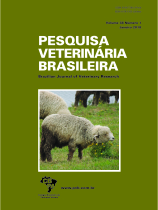 |
|
|
|
Year 2018 - Volume 38, Number 1
|

|
Epidemiological, clinical, pathological and morphotinctorial features of fourteen cases of nocardiosis in dogs, 38(1):99-106
|
ABSTRACT.- Frade M.T.S., Firmino M.O., Maia L.A., Silveira A.M., Nascimento M.J.R., Martins F.S.M., Souza A.P. & Dantas A.F.M. 2018. [Epidemiological, clinical, pathological and morphotinctorial features of fourteen cases of nocardiosis in dogs.] Características epidemiológicas, clínico-patológicas e morfotintoriais de quatorze casos de nocardiose em cães. Pesquisa Veterinária Brasileira 38(1):99-106. Laboratório de Patologia Animal, Hospital Veterinário, Centro de Saúde e Tecnologia Rural, Universidade Federal de Campina Grande, Campus de Patos, Avenida Universitária s/n, Bairro Santa Cecília, Patos, PB 58708-110, Brazil. E-mail: talita_frade@hotmail.com.br
This paper describes the epidemiological, clinical, pathological and morphotinctorial characteristics in fourteen cases of nocardiosis in dogs. A retrospective study for the period of January 2005 to December 2015 was made and selected suggestive cases of nocardiosis. The identification and characterization of the agent was performed by special histochemical techniques Methenamine silver nitrate Grocott (GMS), modified Ziehl-Neelsen, Gram stain type modified Brown-Brenn and Giemsa. Were affected predominantly young and in twelve cases were associated with canine distemper virus (CDV). Clinical signs vary from respiratory, neurological and skin changes, mainly related to concomitant infection by CDV. Macroscopically had multifocal areas coalescing, yellowish-white, firm, elevated in surface and deepened the court, sometimes with purulent material, intermixed by irregular reddened areas affecting mainly lungs, lymph nodes, liver, kidneys, and brain. The cutaneous lesions were predominantly observed in cervical and inguinal and ranged from suppurative well as pyogranulomatous. In the histopathologic examination the injury was mainly characterized by inflammation pyogranulomatous, but in some areas there was a predominance of necrossupurativa inflammation, epithelioid macrophages and were frequently observed, forming clusters radiated form, often reminding rosettes. In the histochemical techniques were observed filamentous structures, branched, non-septate, measuring approximately 1µm thick, impregnated on silver staining, stained in red on the modified Ziehl-Neelsen, in blue on Gram stain type modified Brown-Brenn and weakly pale pink in Giemsa. The nocardiosis should be considered in young animals with progressive respiratory and neurological signs, as well as skin lesions involving the subcutaneous tissue and regional lymph nodes. It should be further investigated a possible predisposing factor, such as infection by canine distemper virus and hemoparasites. The diagnosis was established by histopathological examination based on the morphology of the bacteria and their histochemical characteristics, distinguishing mainly from other bacterial and fungal agents and is an important tool for the diagnosis, when the collection of material for cultivation and isolation of the agent is not possible. |
| |
|
|
| |
|
 |